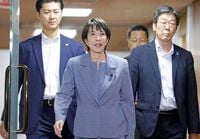On October 21, 2025, the Japanese Diet made history by electing Sanae Takaichi as the country’s 104th prime minister—the first woman ever to hold the nation’s highest office. For many, the sight of Takaichi at the helm of a government long dominated by men was a striking and formative moment, especially for young women across Japan. Yet, this breakthrough is far from a straightforward victory for gender equality or progressive politics.
“It was quite interesting to see how people outside Japan have reacted to the news,” said Ayda Ogura, a 21-year-old student, in an interview with the BBC. “Everyone's like, ‘wow, she's the first female prime minister in Japanese history and that would be a great opportunity for women empowerment and gender equality in Japan.’ I think that's a very naive interpretation.” Her sentiment reflects a broader skepticism among Japanese women, many of whom question whether Takaichi’s ascent will translate into meaningful change for women’s rights or social progress.
Takaichi, often described as a staunch conservative and an admirer of Margaret Thatcher, has built her political identity on traditionalist values. According to The Conversation, she has consistently opposed same-sex marriage, legislation allowing married couples to have separate surnames, and the inclusion of women in the imperial family’s line of succession. While her campaign included softer rhetoric—such as support for tax incentives for companies providing childcare and possible tax breaks for families—her track record aligns with the patriarchal system she now symbolically disrupts.
Observers, both inside and outside Japan, see her leadership as a calculated move by the ruling Liberal Democratic Party (LDP) to shore up its conservative base, which has been drifting toward more right-wing parties. The BBC notes that Takaichi’s rise was powered by support from influential LDP figures, including the late former prime minister Shinzo Abe and Taro Aso, head of a major conservative bloc. Their backing was pivotal in uniting the party’s right wing behind her candidacy.
Despite the historic optics, Japan’s gender gap remains among the most pronounced in the developed world. The 2025 World Economic Forum gender gap index ranked Japan 118th out of 148 countries, with women making up only 15.7% of lawmakers—the lowest figure among G7 nations. Leadership positions in politics and business remain overwhelmingly male-dominated, and societal expectations continue to push women into traditional roles, despite high levels of education and professional qualification.
This week, in a move that underscores Japan’s slow progress on women’s health, the government finally approved over-the-counter sales of the morning-after pill, a form of emergency contraception available without prescription in more than 90 countries. The delay in such basic reproductive rights is emblematic of the broader challenges facing women in Japanese society.
Naomi Koshi, who became Japan’s youngest female mayor in 2012, told Kyodo news agency, “There is great significance in Ms Takaichi becoming prime minister, with a broader impact on society.” She argued that having a female leader could “lower psychological barriers” for women and girls, making it feel more normal to aspire to leadership roles. Yet, as 20-year-old Audrey Hill-Uekawa pointed out to the BBC, “She’s also not really going against the grain. She’s saying the same thing as the men.” For Hill-Uekawa and others, Takaichi’s policies—not her gender—should be the focus of public scrutiny.
Indeed, the question of what Takaichi represents is hotly debated. Minori Konishi, 21, observed, “I do feel that it is difficult for women to sort of relate to her success because it furthers this idea that we must be compliant with the status quo.” Ogura echoed this, warning that Takaichi’s example might raise expectations for other women to conform rather than challenge existing norms. “They're going to expect us to be compliant, not go against the ideals that they have, and it might make our job more difficult,” she said.
Takaichi’s government faces daunting challenges beyond gender politics. Japan’s economy is sluggish, inflation is persistent, and public trust in political institutions has eroded, not least due to a recent political funding scandal that led the LDP’s junior coalition partner, Komeito, to withdraw its support. This left the LDP short of a majority in both houses of parliament, forcing Takaichi into a precarious minority government. After intense negotiations, the right-wing Japan Innovation Party (Ishin) agreed to back her administration, but the coalition still lacks a majority in the lower house, making legislative progress uncertain.
Meanwhile, Japan’s demographic crisis looms large. As The Conversation details, the nation’s population has declined for 16 consecutive years, dropping from a peak of 128 million in 2008 to around 124 million today. The fertility rate hit a record low of 1.15 in 2024, and projections suggest the population could plummet to 87 million by 2070 and just 63 million by 2100, with only half the population of working age. Acute labor shortages are already affecting sectors like healthcare, teaching, and caregiving, while pension and medical costs soar.
Immigration, often touted as a solution to demographic decline, remains a political lightning rod. While Japan’s foreign-born population reached a record 3.6 million—about 3% of the total—in 2025, this is still far lower than in most developed countries. Takaichi supports bringing in foreign workers only for specified fields with strict criteria, such as language proficiency and training, and opposes mass settlement or granting broad political rights to immigrants. Her nationalist rhetoric, which frames foreigners as a potential threat to social cohesion, resonates with the LDP’s aging conservative base.
Instead of embracing immigration, Takaichi and her allies promote pro-natalist policies—encouraging Japanese women to have more children—as a way to address population decline while maintaining cultural homogeneity. This approach mirrors strategies seen in other countries with right-wing governments, such as Hungary, but has yet to yield significant results. Critics argue that such policies are unlikely to improve women’s independence or substantially boost the birth rate.
Internationally, Takaichi’s election has drawn a mix of optimism and caution. U.S. Ambassador to Japan George Glass congratulated her and expressed hope for deepening cooperation in security, technology, energy, and trade. President Donald Trump, scheduled to visit Tokyo for talks on tariffs and security commitments, called Takaichi a “highly respected” leader of “great wisdom and strength.” South Korean President Lee Jae-myung welcomed her appointment, while South Korean media noted her “hawkish” stance and ties to former Prime Minister Abe, raising concerns about future bilateral relations. China, for its part, urged Japan to honor historical and political commitments, especially regarding Taiwan, as tensions in the region remain high. Taiwan’s President Lai Ching-te, meanwhile, hailed Takaichi as an “unwavering friend” and looked forward to closer cooperation.
As Takaichi prepares to host President Trump and faces a host of domestic and international challenges, expectations are high but deeply divided. Her historic rise may have shattered one glass ceiling, but the path to genuine social change in Japan looks as complex and contested as ever.


